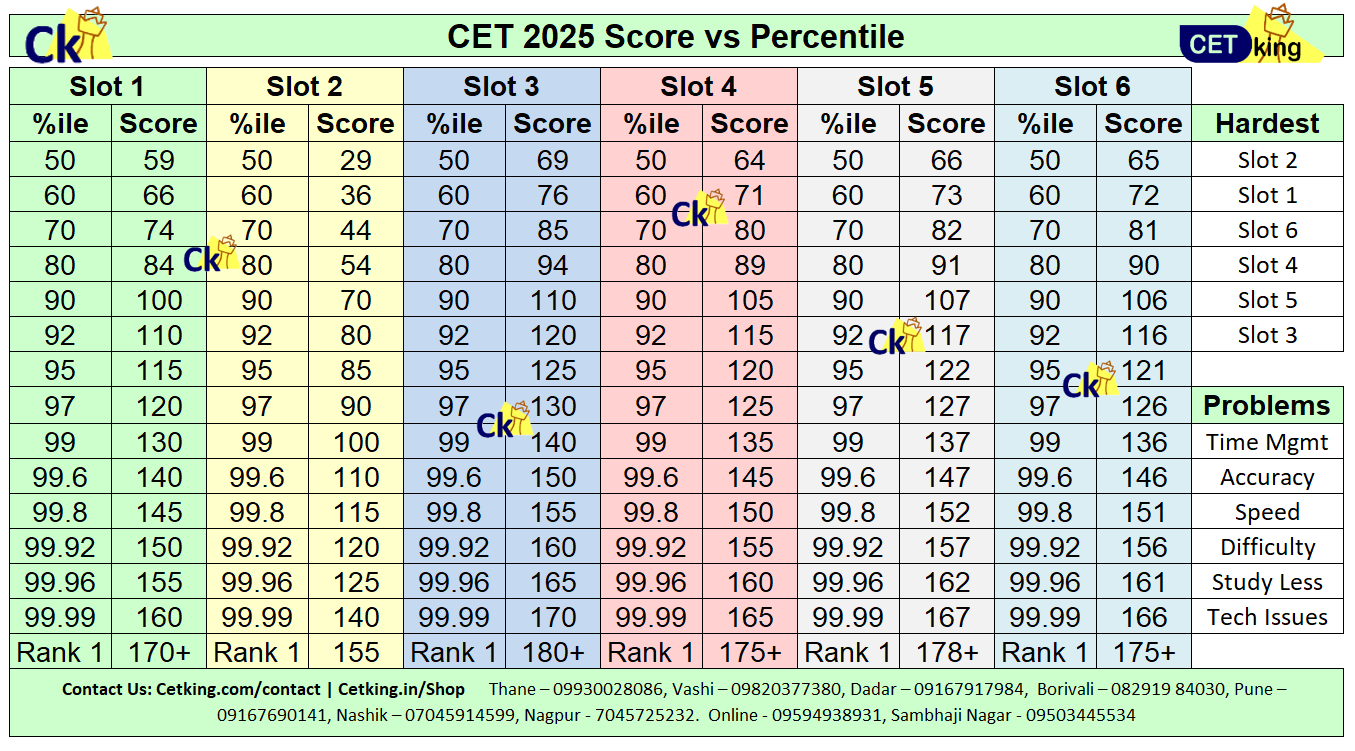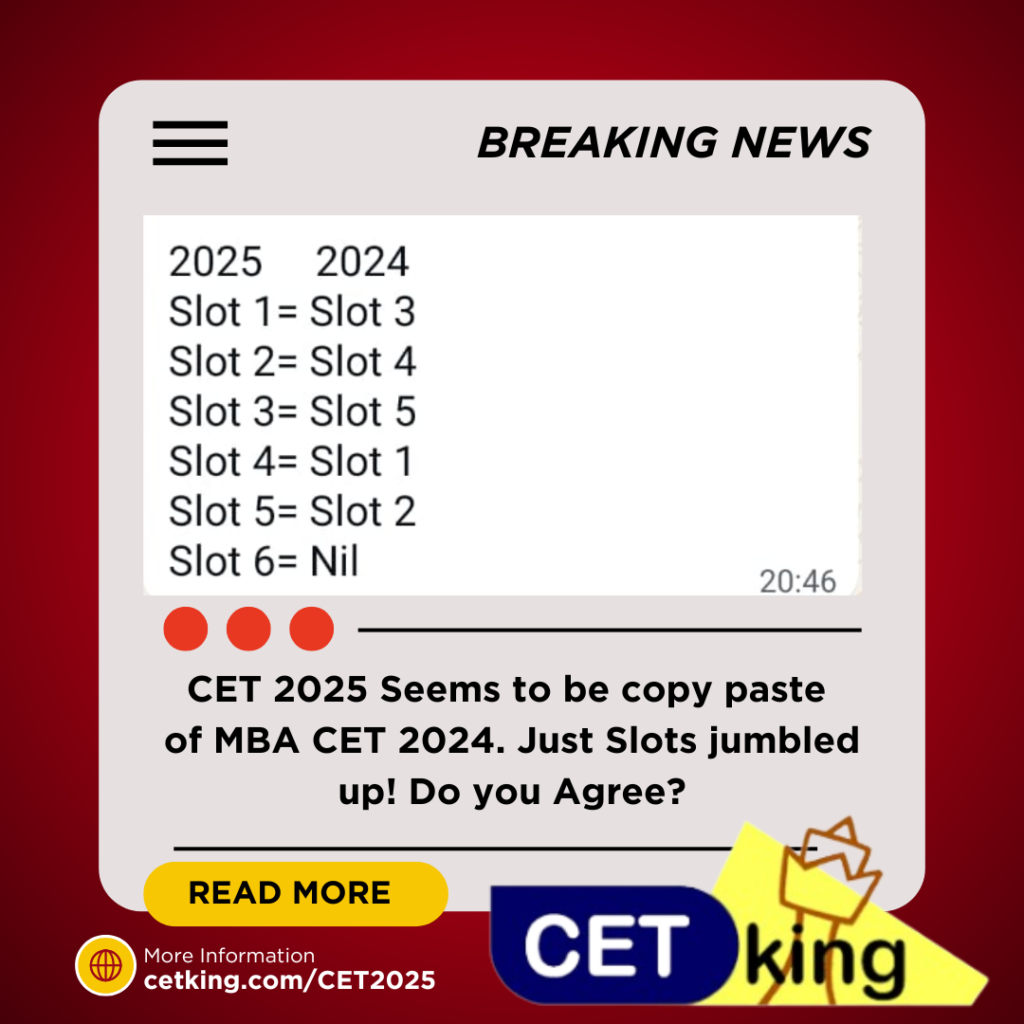MBA CET 2025 Analysis Slot 1 MBA CET 2025 Cutoffs & Analysis Slot 1
MBA CET 2025 Analysis Slot 2 MBA CET 2025 Cutoffs & Analysis Slot 2
MBA CET 2025 Analysis Slot 3 MBA CET 2025 Cutoffs & Analysis Slot 3
MBA CET 2025 Analysis Slot 4 MBA CET 2025 Cutoffs & Analysis Slot 4
MBA CET 2025 Analysis Slot 5 MBA CET 2025 Cutoffs & Analysis Slot 5
MBA CET 2025 Analysis Slot 6 MBA CET 2025 Cutoffs & Analysis Slot 6
Cutoffs for CET Top 100 Colleges 2025
- Top 100 MBA MAH MMS CET Colleges Cutoffs
- Top 50 MBA MAH MMS CET Colleges Cutoffs
- Top 30 MBA MAH MMS CET Colleges Cutoffs
- SIES Nerul MMS Cutoffs
- Welingkar MMS Cutoffs via MBA CET
- St. Xavier’s MMS Cutoffs Mumbai
- PUMBA MMS Cutoffs Pune University MBA
- COEP MMS Cutoffs MBA BA Programs
- Sydenham Cutoffs and Seats distribution
- JBIMS Cutoffs and Seats distribution
- Top 15 MAH MBA CET Colleges Cutoffs for MBA CET
- Top 10 MAH MBA CET Colleges Cutoffs for MBA CET


- Kuch bhe ho sakta hai Paper Pattern
- Ek section will be tedha G Strategy
- Easy Medium Hard!
- One Topic 10-15 Questions
- 25/20 Strategy
- Go through G Strategy of missing topics
- Confidence level high!
- Check out CET Slot 4 paper
- Score vs Percentile
- Abstract Logic is not always easy!


| Expected CET Paper Section wise Tests | Link |
| MahaYagya 1 Abstract Traditional | Cetking.com/Abstract |
| MahaYagya 2 Quant Numbers | Cetking.com/Quant |
| MahaYagya 3 Puzzles Matrix Circular | Cetking.com/Puzzles |
| MahaYagya 4 Numbers LCM HCF | Cetking.com/Quant |
| MahaYagya 5 Arithmetic & DI | Cetking.com/Quant |
| MahaYagya 6 ModernMaths | Cetking.com/Quant |
| MahaYagya 7 Time Speed Work Mensuration | Cetking.com/Quant |
| MahaYagya 8 Traditional Logic | Cetking.com/Logic |
| MahaYagya 9 Modern Logic | Cetking.com/Logic |
| MahaYagya 10 Verbal Vocabulary | Cetking.com/Verbal |
| MahaYagya 11 Verbal Reading Based | Cetking.com/Verbal |
| MahaYagya 12 Verbal Grammar Idioms | Cetking.com/Verbal |
| MahaYagya 13 Abstract Modern | Cetking.com/Abstract |
📌 What is the CETking 25/20 Strategy?
The strategy divides your test attempt into multiple 20-minute time blocks, where your goal is to solve 25 questions per block. The complete plan is broken into 8 such phases (some shorter at 15 minutes), aiming to attempt the paper efficiently across sections and difficulty levels.
🧠 Core Idea Behind the Strategy
The name “25/20” comes from:
- 25 Questions to be attempted
- 20 Minutes to be used
This ensures you’re not wasting time stuck on any single question or section. You get to maximize your score by solving the questions you’re strongest at first, and using the remaining time for tougher or time-consuming parts.
🔁 The Strategy Broken Down
Let’s understand the plan step-by-step from the image:
🔹 Section 1 (40 mins)
- First 20 mins → 25 questions (Scan for easy questions)
- Next 20 mins → Another 25 questions
Tip: Start with your comfort zone—whether it’s verbal or logical reasoning. Skim and scan to find easy questions in these initial 40 minutes.
🔹 Section 2 (20 mins)
- Attempt next 25 questions (these can be from Quant, Verbal, or DI depending on your strength).
Tip: Stick to your favourite topics—this ensures you maximize accuracy and speed early on.
🔹 Section 3 (60 mins total in 3 parts)
- First 20 mins → 25 questions
- Next 20 mins → 25 questions
- Another 20 mins → 25 questions
This section is where you’ll go deeper into the tougher parts of the paper. It can include moderate-to-difficult reasoning puzzles, data interpretation, or paragraph jumbles.
Tip: Use your second phase strategy here. After completing the easy questions in Phase 1, now attempt the medium and hard ones if time permits.
🔹 Section 4 (Final 30 mins)
- 15 mins → 25 questions
- 15 mins → 25 questions
In this phase, attempt leftover questions, make educated guesses (tukka) if required, and revisit any marked questions.
Tip: Use this time to apply the Garib Strategy—a humorous but smart term used to describe tactical guessing, shortcut solving, and strategic elimination.
🚀 How to Use This Strategy During the Exam
Here’s a more practical interpretation of the approach:
1. Scan First
Spend your first few seconds/minutes scanning the section and marking easy or familiar questions. Don’t solve in sequence. CET isn’t about order—it’s about optimization.
2. Two-Phase Method
Split your time into:
- Phase 1 (Easy First): Solve all quick wins.
- Phase 2 (Backtrack): Revisit tougher ones and tackle them with fresh eyes.
3. Favourite Topics First
Start with the areas where you’re most confident—Quant, Verbal, Puzzles, DI, whatever your strength is.
This boosts confidence, builds momentum, and prevents early burnout.
4. Leave Time Drainers
Skip the questions that:
- Involve lengthy calculations
- Seem unfamiliar
- Are time-consuming logical puzzles
Return only if time permits.
5. Garib (G) Strategy
This is a cheeky way to say: be smart and tactical.
- Use options to reverse-solve questions.
- Apply elimination.
- Use known CET patterns (like often repeated puzzles or reasoning tricks).
6. Tukka Strategy
In the last few minutes, go for educated guessing.
- Avoid blanks. There’s no negative marking.
- Don’t tukka blindly—choose options that appear most reasonable based on common sense, pattern spotting, or partial solving.
🧩 Mental Strategy and Time Discipline
The CETking strategy helps you avoid two major pitfalls:
- Spending too much time on one section (usually puzzles or DI)
- Running out of time with many questions untouched
By capping each batch of 25 questions to 20 minutes, you’re essentially training your brain to move fast and keep pace. If you aren’t done in 20 minutes, move on.
This requires practice. You can simulate it in your mocks by setting a timer for every 20 mins and moving sections forcibly.
🧘 Mindset Tips for the CETking Strategy
- Don’t panic if a section is tough. Just move on. There are always easier sets/questions elsewhere.
- Train your brain for transitions. You’ll need to jump from Quant to Verbal to DI to puzzles quickly.
- Accuracy over speed at first, then speed over perfection. You don’t need 100% accuracy. A score of 120–130+ is usually enough for JBIMS.
📊 Final Words – Why This Works
- It keeps you organized under pressure.
- Helps you maximize attempts without burnout.
- Lets you adapt on the go—switch between sections based on real-time difficulty.
- Leverages familiarity and strengths first.
In CET, the paper is a mix of predictable and unpredictable elements. The CETking 25/20 strategy gives you a repeatable method to handle both, with flexibility built in.

